Google Gears
Pretty cool!
Google published Google Gears a plugin that exposes an APIs to Javascript applications for off-line storage.
It also comes with an embedded Sqlite3 database, very nice.
Posted on 31 May 2007
Occupation 101 Released
Occupation 101 has finally been released, after years in production the movie can now be purchased on DVD.
This is an incredibly important movie to understand the living conditions of the palestinian population in the West Bank.
The Production
The movie was directed, shot and produced by two guys which explains why it took so long for the movie to be released.
Resources
B'Tselem: The Israeli Information Center for Human Rights in the Occupied Territories (West Bank and Gaza) has extensive information.
John Pilger's Palestine is Still the Issue documentary is now available on video.google.com.
Posted on 31 May 2007
Novell and the EFF Announce Patent Reform Partnership
Nat was today in San Francisco to announce Novell's partnership with the EFF to work on Patent Reform.
The details can be found here.
"EFF is partnering with Novell to try to get rid of software patents that are hurting innovation all over the world," stated Shari Steele, Executive Director of the EFF in an interview prior to the panel session.In essence, Novell is committed to working with the EFF to improve patent quality, while at the same time work to lobby with government agencies to reform existing patent policies and litigation, according to Nat Friedman. Novell's Chief Technology and Strategy Officer for Open Source. Specifically, Novell will assist the EFF in two ways.
First, they will work with and support the EFF's existing Patent Busting Project, which targets existing patents that cover technology concepts that are perhaps to fundamental or already have prior art.
"They're awarded for fundamental concepts in computer science on a too regular basis," Friedman stated. "Things like XOR, the ISNOT operator."
"If you go on our Web site," Steele added, "we asked Internet users to identify the ten most egregious patents out there. We have our 'Ten Most Wanted.' And we've been one by one hacking away away at them."
The second part of the partnership will have Novell working with the EFF and legislators to lobby for patent reform, initially in the US, but also branching out to Europe, where patent problems continue to arise. The EFF and Novell will also work with standards groups to assist in patent reform.
The news is notable because it's the first time, Steele confirmed, that a corporate entity has publicly thrown in this level of support for the EFF on the patent issue. Normally, Steele said, companies have been much more circumspect and allowed the EFF to solely take the lead on this issue.
The goal is to continue defending Linux from IP threats (as we have done in the SCO lawsuit that has costed Novell millions of dollars) and as we did when we were one of the founding members that contributed significantly to the creation of the Open Invention Network.
Posted on 23 May 2007
Dynamic Language Runtime: The Slides
For those of you that could not attend the Compiler Lab but would like to see the slides, John Lam has published two slide decks:
Posted on 23 May 2007
Compiler Lab: Second Day
Today was a bonding day for those of us that attended the Compiler Lab, after the morning session and the lightning talks were over most of us stayed around and talk until the end of the day.
In the afternoon, while some of us were busy schmoozing and debating important topics like what was better: Jon Stewart or the Colbert report and lamenting the results of the French elections some other people were actually busy hacking in the afternoon.
Apparently some folks that are working on a ColdFussion compiler got their Cold Fusion compiler using the DLR. Rodrigo and JB were also quite busy hacking in the afternoon.
Good news for Boo users: after I posted my message yesterday about readline-like functionality Cédric Vivier pointed out that he had just implemented the readline capabilities in Booish. You can see the details here.
Hosting and the Case for Multiple Hosts
The morning sessions focused on how to host DLR-bound languages into an application and the various services offered by the DLR infrastructure.
A question that came up is whether it is necessary to support more than one hosting "context" in a single application. Where global variables and types would be shared across multiple scripting instances.
Although today the DLR does not support more than one context, I believe that it should support independent contexts. A case was made for Processes and AppDomains already existing and that adding a scripting contexts was not necessary but if there were interesting scenarios for this setup they could look into it.
In my opinion, AppDomains are too heavy of a separation barrier in an application. They are hard to setup properly and depending on them requires an entire application to be restructured around this new boundary. In the particular case of Boo, multiple hosting environments can exist in a single application and I think this is a good thing.
The best use can I can think of for the need to have multiple hosting contexts would be if the DLR is hosted in two independent libraries A and B developed by two independent groups and then having both of those libraries consumed by a third party. The developers of A and B should not have to talk to each other.
Another example: I could imagine a setup where I want a scripting context for extending the internals of my application and on the same process, I would like to have a second scripting context that does not have access to the internals of my application, but instead is used by the user to write/prototype whatever it is that my application hosts.
An accounting application that is heavily scripted internally would use one hosting context for its internal scripting facilities: forms, rendering, accounting and another scripting context would be used for doing report scripting: a much more limited environment that would not get access to all the application internals and types and globals, but only those that make sense for the reporting infrastructure.
Anyways my vote: yes, we need multiple hosts per AppDomain.
There was a demo of some scripting editor during the talk that hosted the DLR itself but Google does not turn up anything useful about it (Nessie), it looked cute.
DLR Code Generation Scenarios
In the second part of the sessions they showed some examples of what kind of code IronPython, IronRuby and the Javascript compilers generate.
The DLR in particular provides support for capturing the environment (to create proper lambda functions). A key point during the presentations was that providing as much information the DLR as possible allowed it to optimize the code.
Rodrigo -the author of Boo- pointed out during one of the breaks that he did like the optimizations that scripting developers were getting for free.
Milo: Compiler Infrastructure
In a similar spirit to what the DLR team did by refactoring IronPython into the DLR and then growing languages out of it, Rodrigo and JB talked about a similar project.
Based on the Boo codebase and their joint work on Cecil while they both worked at db4objects they created Milo (which is available here: http://code.google.com/p/milo/.
Milo's goal is to simplify the development of a compiler that targets the .NET framework
Cute Anecdotes
Their new DLR-based Javascript compiler (that implements the current ECMA spec) was written by two developers in four months. Nandan Prabhu was at the conference and he explained that if they were to rewrite it today it would probably take three months for a programmer to implement as such a person would not have to keep up with the daily changes in the DLR.
The current sizes for the runtime and the compiler are:
-rw-r--r-- 1 root root 114688 2007-05-02 04:07 Microsoft.JScript.Compiler.dll -rw-r--r-- 1 root root 299008 2007-05-02 04:07 Microsoft.JScript.Runtime.dll
Extrapolating that from our compiler source code it seems that the code is roughly 35,000 lines of code for both the compiler and the runtime. And the compiler is only one fourth of that, so something in the 9,000 line range.
Another interesting detail: the new Javascript compiler is written in Visual Basic.NET.
Dinner
The day ended up with a fascinating discussion in the kitchen with the Jims (Miller and Hugunin) about languages, big integer support, scheme, python, academia and practice and tons of anecdotes of the early days of the CLR and Jim's days at MIT.
Posted on 23 May 2007
Moonlight, trivial Video and Canvas
As part of my Silverlight for Linux research I have prototyped a native code library that uses Cairo and ffmpeg to prototype some of the ideas from the Silverlight canvas.
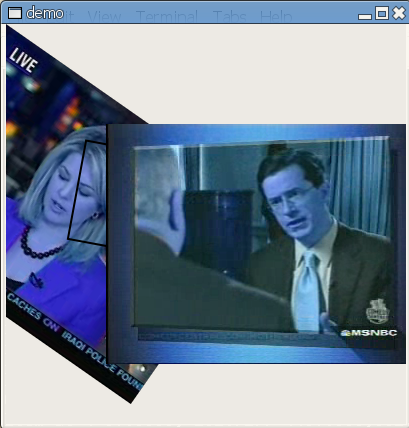
The above picture shows 2 videos playing, one of them rotated and a triangle object rendered in the middle as well. This was just a test to get an idea of what is involved.
The code does no attempt to keep up with the clock or do anything reasonable with time: it just renders stuff as fast as it can and does have no audio support. The next step is tune this a little bit (I do too many copies right now, too much stuff is done on the critical path) and then contrast this with an Agg-based implementation.
The canvas implementation that am using right now is inspired by the Gnome Canvas in many regards.
Compiler Lab: First Day
Today was the first day of the Compiler Lab and got to see again many good friends and some folks I had not seen for ages. This will feel like a name-dropping blog post, but here it goes anyways.
Scott Gunthrie introduced the day with a general overview of where they are and where they are going with .NET, Silverlight and WPF.
JB Evain and Rodrigo Oliveira were both late for the opening session, but they looked like they had been hacking all Sunday.
Jim Hugunin introduced the Dynamic Language Runtime in the second half of the morning and went through the design decisions behind the DLR. Although he has covered some of this information in blog this presentation was colored with the history of how decisions were made and the engineering choices that they had made that took them from IronPython to work on a general purpose framework for hosting dynamic languages.
The historical bits are always the most interesting to me. Jim talked about how they decided to go for a general purpose framework as people started asking for support for more dynamic languages. They were not really interested in writing all the compiler themselves, so instead they decided to turn their experience in building IronPython in some reusable work that could be used by others.
To accomplish this, they chose to implement four different dynamic languages extracting the common infrastructure into a reusable framework. Jim did not say how much they had learned from each language (which I guess is a good question for tomorrow), but he mentioned that the DLRConsole sample for Silverlight originally was pure Python. That it took him about three hours to add Javascript, three days to get Ruby in shape to work on the DLR and their new VisualBasic required almost no work.
I have extensive notes, but they are too extensive and am not sure I want to edit those, but you can get a good idea of what the presentations were all about from his blog posts:
- A Dynamic Language Runtime
- The One True Object.
- The One True Object, part 2: where Jim introduces the idea of message passing as the universal mechanism for hosting dynamic languages instead of object wrapping.
- DLR Trees: the default AST representation that dynamic language authors can use to take advantage of the DLR.
The DLR is pretty serious, there were at least six people in the audience from the DLR team. I finally got to meet Dino Viehland, Bill Chiles was handing out copies of ToyScript (a reference small interpreter), Martin Maly was there, John Lam sat on the back (we all presume he was working furiously on his presentation for tomorrow) and Mahesh Prakriya was there as well.
Jim Miller of Scheme fame was there and made things all the more amusing by pointing out the similarities of certain features to Scheme. He also brought up a few issues that would need to be included in the DLR to support languages like Scheme as the day went by.
Jim Hugunin has always found interesting ways of demoing IronPython. He used to build a calculator with Avalon and rotate the buttons. Today he showed us some XNA space ship controlled with an Xbox control and later used IronPython to control a Lego Robot that his nine year old son had built.
John Gough was also here and he has retired from teaching at QUT. Nigel Perry has left the University too and is now working at Microsoft.
John Lam is organizing the lightning talks, and he has divided things neatly into three categories: Monday was the day for 5 minute talks. Tuesday was the day for 10 minute talks and Wednesday is the day for 15 minute talks.
When I left the building there were zero talks scheduled for 5 or 15 minutes. Everyone is listed on the 10-minute column for tomorrow.
I had a fantastic dinner with Scott Gunthrie and Jason Zander. I got a chance to pepper them with questions about the early history of the .NET framework for my pet project on the archaeology of .NET to be published in May 2nd, 2076. They were also kind enough to explain to me some of the technicalities about the Silverlight implementation. I should be updating the wiki page with the details later.
Help Rodrigo
Apparently "Console.ReadLine" on Cygwin in some way gets line editing even from C# applications. Am not sure how this works, but Rodrigo can not live without this feature in Booish.
I remember that a few years ago there was a Unix program that will provide readline capabilities to any program that lacked them by running a process under a pseudo terminal and providing line editing functionality to tools like ftp, nslookup or any other Unix tool that did not provide its own command-line editing functionality.
Posted on 22 May 2007
Rob Connery Interviewed
In this interview Rob Connery explains how he came up with SubSonic. A tool that helps developers build applications:
That someday came when I was refactoring the Commerce Starter Kit, trying to leverage as much Data access code into the base classes as I could. I was using generics in a way that they probably weren’t designed to be used, but in the process I stumbled on a really cool pattern for generating very little code for a full data access layer. When I first got it to work I literally jumped out of my chair, swearing to myself.I gave it about 2 weeks and tested and tested and when it didn’t break or slow down, I remember thinking "I’ve got something here!". I had been doing some Ruby/Rails stuff at the time, and I had the idea that much of that ΄love‘ could be brought over to the ASP world. Although the real joy of Rails is the language Ruby - but maybe someday RubyCLR will be finished (or some other dynamic language package for .NET) and that’s when I think SubSonic will come into it’s own.
Through Phil Haack
Once Subsonic runs on Mono, we should integrate it into MonoDevelop. Rob did a great demo of it at Mix.
Posted on 22 May 2007
Compiler Lab Meeting at Microsoft
I will be arriving at noon to Redmond on Sunday and spend Monday and Tuesday (skipping Wednesday) at the Compiler Lab meeting at Microsoft.
Drop me a note if you want to get together on Sunday afternoon or swing by and say hi during the meeting.
Rodrigo de Oliveira from Boo fame and JB Evain will be both there as well.
Mono and the Dynamic Language Runtime (DLR)
Thanks to Zoltan Varga, Marek Safar and Sanghyeon Seo it is now possible to run the Dynamic Language Runtime in Mono and run the new DLR-based IronPython 2.0 in Mono.
Update: Mono already supports the pre-Alpha releases of IronPython and has for a long time. What is different is that this is the DLR-based IronPython.
The changes did not make it into Mono 1.2.4 (Mono 1.2.4 was branched before MIX 07 even started, or the DLR was announced). So you will need to build Mono from the source on SVN or wait for Mono 1.2.5 to include the fixes.
Posted on 17 May 2007
Paint.NET 3.0 for Mono: Now Public
 We have used Paint.NET for a long time
as a test for our Windows.Forms implementation. In the past I
have blogged about it (here
and here).
We have used Paint.NET for a long time
as a test for our Windows.Forms implementation. In the past I
have blogged about it (here
and here).
Until now, releasing the port was either painful (because I had botched the 1.x port) or not very useful (because newer versions of Paint.NET depended on 2.x features that we were missing). In Mono 1.2.4 we finally have an implementation of the *Strip classes that are heavily used in Paint.NET for the menus, toolbars and floating editing gadgets so now Paint.NET looks great.
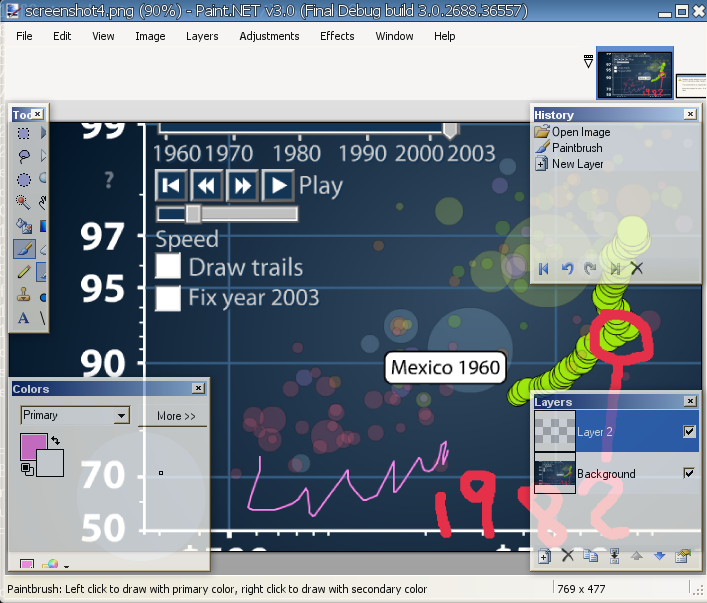
The port is not complete, but it works. Am releasing it to the public since so many people asked about it and volunteered to contribute to complete the port.
Links:
- The project home page.
- The Porting Strategy document.
- The discussion group for the port.
Feel free to join the effort.
Posted on 15 May 2007
Mono.DataConvert
Our just released Mono 1.2.4 contains a class that replaces System.BitConverter: Mono.DataConvert.
We created this interface a few months ago when we ran into problems with the limitations in System.BitConverter in Mono and when we noticed that it was not possible to fix this API. Mono is switching internally to use this instead of BitConverter as it leads to subtle errors when making your code work in big-endian systems.
Mono.DataConvert offers conversions from and to .NET types to raw byte sequences:
- Host types to native byte arrays, little endian byte arrays and big endian byte arrays.
- native, little endian, big endian to Host types.
- Helper routines for Stream I/O.
- Perl-like convenience routines for packing and unpacking data structures.
I like the Perl-like interface, for example:
// The following means:
// Little endian encoding of a Int16, followed by an aligned
// int32 value.
byte [] r = DataConverter.Pack ("_s!i", 0x7b, 0x12345678);
DataConverter.Pack ("^ii", 0x1234abcd, 0x7fadb007)
// Result: 12 34 ab cd 7f ad b0 07
We also have a more traditional APIs, for example:
// The instance-based API byte [] x; x = DataConverter.LittleEndian.GetBytes (my_double_value); x = DataConverter.Host.GetBytes (my_double_value); x = DataConverter.BigEndian.GetBytes (my_double_value); // Or a static version of it: x = DataConverter.GetBytesLE (my_double_val); x = DataConverter.GetBytesNative (my_double_val); x = DataConverter.GetBytesBE (my_double_val);
The code is licensed under the MIT X11 license, and we encourage developers on both Mono and .NET to use this library as opposed to the fundamentally limited and broken BitConverter.
This class is bundled as part of corlib, and is by default "internal". Since this is a small class, developers are encouraged to copy the source code into their own applications. See this for details
Posted on 15 May 2007
JB Evain joins Novell
 Jean-Baptiste Evain, the author of Cecil the CIL
manipulation library that is now used by various Mono
components as well as the Mono Linker has
joined the Mono team at Novell.
Jean-Baptiste Evain, the author of Cecil the CIL
manipulation library that is now used by various Mono
components as well as the Mono Linker has
joined the Mono team at Novell.
Posted on 15 May 2007
أهلاً حَبِيبين,أهلاً (Ahlan habibin, ahlan)
J'ai essayé de faire une interview en Français l'autre jour, mais mon français est pire chaque année, vous pouvez la voir ici.
J'y parle de nos plans d'écrire une version libre de Silverlight pour Mono.
Autres nouvelles: j'adore Arvo Pärt et pour quelque raison mon Emacs ne fonctionne pas avec l'arab. of أهلاً
Posted on 13 May 2007
TimeZoneInfo in Mono
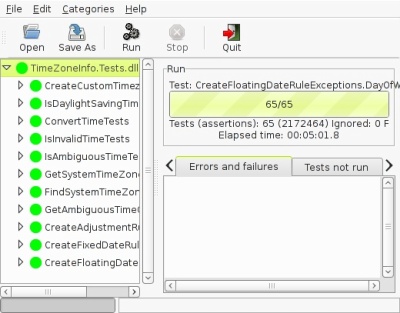 A few months ago, Stephane
Delcroix was working on F-Spot and he needed to track
time zone information for pictures.
A few months ago, Stephane
Delcroix was working on F-Spot and he needed to track
time zone information for pictures.
The .NET framework did not offer anything to make this easy. Only one timezone could be constructed: the system one.
His original plan was to implement Mono.ExtendedTimeZone that would be a derived class from the TimeZone class in the framework but that would be populated from some other database.
He considered a few choices and discussed:
- Use libc in some form, to pull the data out of it (external program) and create the instances of the timezone as needed. This could be slow due to using an external program with a temporary TZ setting.
- Parse the libc datafiles, very OS/distribution-specific.
- Ship our own databases.
We did not want to go into the business of maintaining the timezone files and redistribute Mono updates every time new countries were created or rules changed, so we opted for dumping the data out of libc in some form.
Stephane ended up parsing the GNU libc datafiles: they did not depend on external programs, works on Linux easily and is fast. This will require the code to be ported to other platforms though.
Around that time we discovered that Orcas (.NET 3.5) included a class to cope with this problem in the form of System.TimeZoneInfo in the System.Core.dll assembly. So his API effort changed from implementing a Mono.ExtendedTimeZone to implement System.TimeZoneInfo. Yesterday he emailed me the above screenshot and we got the code commited to SVN.
Check Stephane's PicasaWeb album it contains various screenshots of his F-Spot work.
Posted on 12 May 2007
C# 3.0 updates
Scott Peterson blogs about his recent contributions to the C# 3.0 compiler:
Variable type inference (the "var" keyword) Anonymous types. Implicitly typed arrays. Object initialization. Collection initialization.
Scott is participating in the Google Summer of Code. His summer project is to port the Banshee Media Player to Windows. But I guess he had to have those 3.0 features before he could start. It makes perfect sense. This patch was reviewed and mentored by Marek Safar who has been implementing various other parts of the C# 3 support (extension methods, the new LINQ parser and the updated delegate semantics).
The new object initialization allows properties to be set at construction time, for example:
// C# 2 style
Gtk.Window w = new Gtk.Window ();
w.Title = "My App";
w.Visible = true;
// C# 3 style
Gtk.Window w = new Gtk.Window () { Title = "My App", Visible = true };
This also works for events:
Gtk.Button b = new Gtk.Button ("Ok") { Clicked = ok_clicked };
Or using the new lambda expressions:
Gtk.Button b = new Gtk.Button ("Ok") {
Visible = true,
Clicked = (sender,args) => { Console.WriteLine ("Clicked"); }
};
The last case (delegate) is currently not supported by mcs.
Posted on 09 May 2007
Dynamic Language Runtime
The presentation by Jim Hugunin and John Lam on the Dynamic Language Runtime (DLR) was a great introduction for the general public on what they are trying to do.
They showed their Ruby compiler consuming JavaScript and
Visual Basic code from a single program:
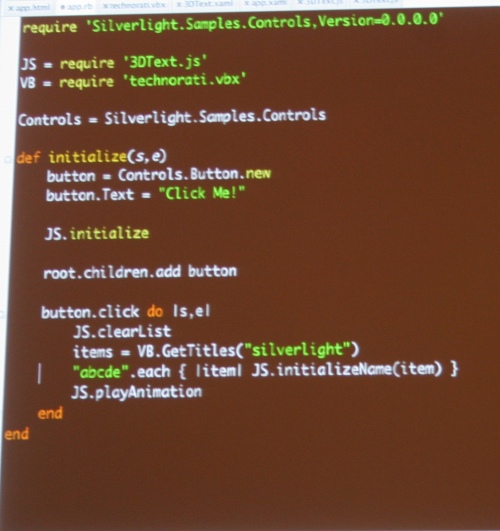 In the above example, Ruby has been extended to allow
importing modules, for instance
In the above example, Ruby has been extended to allow
importing modules, for instance
JS = require '3DText.js'
Imports the code that does 3D transformations (written in Javascript) into the constant JS. To access functions in that javascript module, you just prefix the call with JS, like show on the screenshot (JS.playAnimation for example).
The Dynamic Language Runtime augments the Common Language Runtime and is made up of a few chunks:
- A shared type system for dynamic languages.
- A shared AST that can be used by language developers to create new dynamic languages.
- Helper/utility routines for compiler developers.
- A common hosting interface, to embed the general purpose scripting language interface into your program, and allowing developers to extend applications with one or more dynamic languages.
- Console support, they even have a simple console interface for doing interactive programming.
Today Jim has a post describing in more detail the shared type system:
They demonstrated the DLR Console, a sample application written in IronPython that allows developers to interactively write and test their code for Silverlight.
You can watch the presentation here.
Variables and functions declared in one language are automatically visible to the other languages, and by clicking on the language at the bottom of the screen programmers can switch between languages on the same session.
My photo did not come out very clear, but in this shot you
can see vb, javascript and ruby. The popit routine written
in VB, the event wired up in Javascript, and another event
wired up in Ruby:
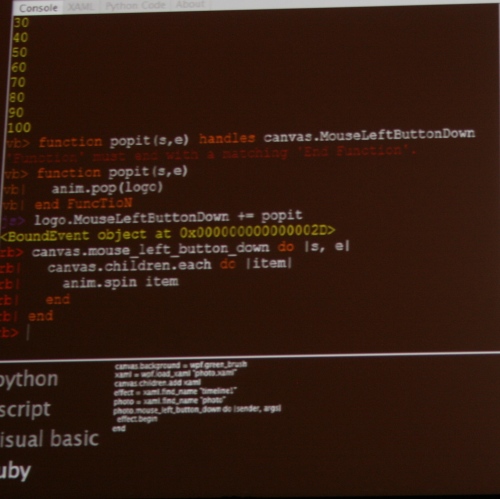 An interesting feature of the DLR is that they added a
mapping system for function names, so that code does not feel
alien in other programming languages.
An interesting feature of the DLR is that they added a
mapping system for function names, so that code does not feel
alien in other programming languages.
So the event MouseLeftButtonDown from the CLR is exposed to
NRuby as mouse_left_button_down in Ruby, here you can see
auto-complete when running under the Ruby context:
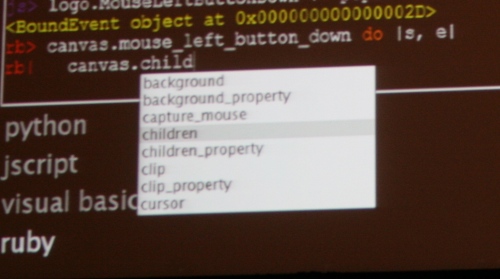 Those properties in .NET are capitalized.
Those properties in .NET are capitalized.
Various technical details appear on this interview by Darryl Taft:
Hugunin: In many ways, all the DLR does is it takes these things that we did custom for IronPython and it makes them work for a broad spectrum of languages. So instead of having a Python type system we now have a dynamic type system. So any language that has dynamic operations can share them
The DLR and Mono
As usual, Hugunin's team keeps exposing bugs in our compiler. For example, we did not notice when C# 2.0 came out that the operator declaration grammar now allowed for attributes on operator parameters:
operator-declaration:attributesopt operator-modifiers operator-declarator operator-body
That one is fixed on SVN, but am not sure its worth backporting to the 1.2.4 branch. Another issue seems to be a case of not implementing fully method group conversions as the code seems to be comparing a delegate variable against a method and we barf on that one. A simple fix for now is to merely do a manual conversion in the source "new DelegateType (Method)".
I did not research this one yet, but plan on doing that today.
The final issue seems to be an issue with the operator priorities, our compiler does not like expressions like this:
type t = var as TypeName ?? dingus;
A temporary fix for now is to put parenthesis around "var as TypeName". It should be an easy fix
With those fixes you can get the DLR building on Mono, I have not tried the rest of IronPython as am just freshly unpacked from Vegas.
JavaScript
Deepak Jain pointed out by email that the Javascript support in the DLR is their new engine, and not a research prototype.
This new Javascript implementation is following the steps of IronPython: to be true to the original language without .NET extensions. So this is different than JScript.NET that added a bunch of extensions to be a CLR citizen.
Their new ECMAscript implementation is more of a DLR citizen and true in spirit of it.
Ruby, Python and the DLR are released under the MsPl, and it would be great if they also did this for Javascript.
Posted on 03 May 2007
Digger on Silverlight
So we have all seen the spinning text, the video puzzles and the rotating spiderman trailer.
But real programs are more complicated than those simple demos. Lutz Roeder has a page with Silverlight applications that he has written.
My favorite: his Windows.Forms digger port. You can see it here or you can download the sources and learn for yourself here.
Posted on 03 May 2007
Mike Krueger Joins the Mono Team
Mike Krueger, the creator of the Sharp Develop IDE, has joined Novell.
Mike will be working with Ankit, Lluis and Jeff to improve the MonoDevelop IDE, and to try to share more code between SharpDevelop and MonoDevelop.
Posted on 03 May 2007
Mix 07, Silverlight, Dynamic Languages Runtime and OpenSource
A very impressive set of demos at Mix 07, the 72 hour conversation that Microsoft is having in las Vegas.
The focus was mostly around Silverlight, Microsoft's new web plugin to author rich application and tools used to design this content.
The whole Expression suite was adorable, and Blend is fantastic.
The demos were pretty amazing, Scott built a nice animation for an airline reservation system on stage:
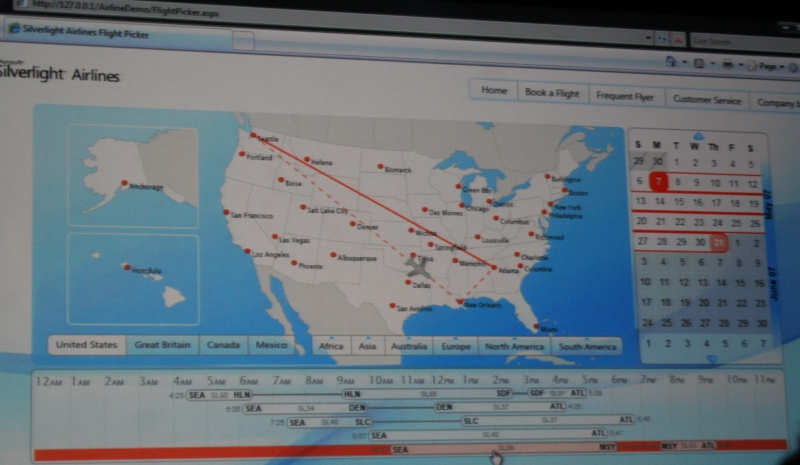
Silverlight and WPF
Today Microsoft announced two Silverlight editions: one that went into beta (Silverlight 1.0) and is a relatively simple technology.
Silverlight 1.0 uses a retained graphics system (a canvas) that exposes the internal structure to the browser DOM. It has no scripting capabilities built into it, all the scripting support is actually done by the Javascript interpreter in the browser and all changes are done by talking to a Javascript object exposed by the hosted Silverlight surface.
The scene definition is done using the XAML markup using a subset of the WPF primitives available in the full-blown WPF. Then the big announcement came:
The second edition was Silverlight 1.1, and this one is a different beast altogether. 1.1 extends the model by embedding a complete Common Language Runtime. Here is the slide that Scott used for this part of the presentation:
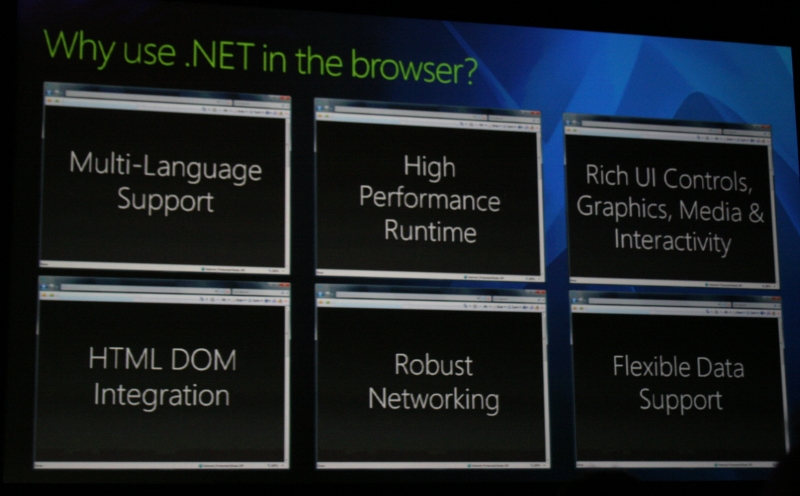
Scott did a demo of a chess program that had logic built with JavaScript and C#, notice the nodes per second computation:
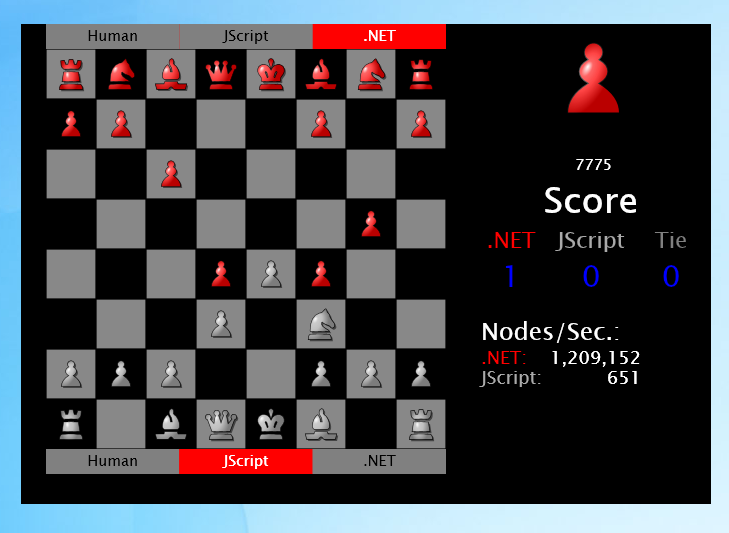
The outcome of the famous battle between dog vs vampire:
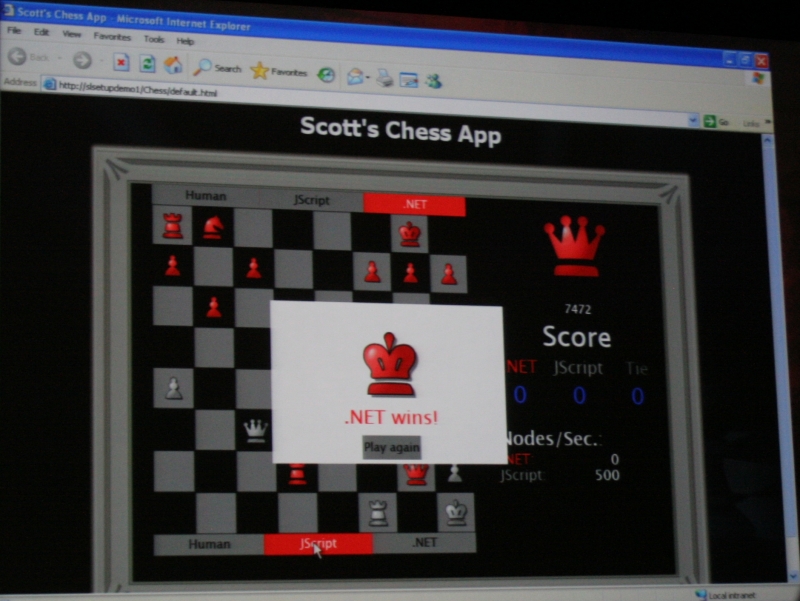
There are a handful of changes to the runtime. Here are some notes on what I found out about it today. It might not be complete nor accurate:
- A new security system: Unlike the CAS there is no stalk walking but instead there are trusted and untrusted assemblies. This is part of a new sandboxing model.
- Trusted assemblies have a way of flagging entry
points as being untrusted. which requires that the
caller be a trusted assembly.
This means that calling things like FileStream File.Open (string filename) from an untrusted assembly is not permitted.
Instead developers would call something like FileStream File.OpenDialog(...) (which is hosted in a trusted assembly) and this would in turn call File.Open(string) and this would return a FileStream that the user selected with a dialog box.
- The API has been trimmed down: some classes were removed that did not make much sense for the core.
- A Minimalist WPF implementation: this is
now available as a new assembly. This implementation
at this point does not seem to have support for
high-level controls like Buttons or Sliders, those
have to be authored in a per-application basis.
There is talk about which pieces belong in the minimal WPF and which pieces do not.
In my opinion, keeping the controls out was a good idea as the controls in the real WPF are a bit too big.
- Dynamic Language Runtime: the dynamic language runtime is an integral part of the Silverlight distribution.
Dynamic Language Runtime
The Dynamic Language Runtime was announced today. Jim Hugunin's blog has the details and rumor is that in the next couple of days/weeks he will be posting on his blogs the technical details behind the design of the DLR.
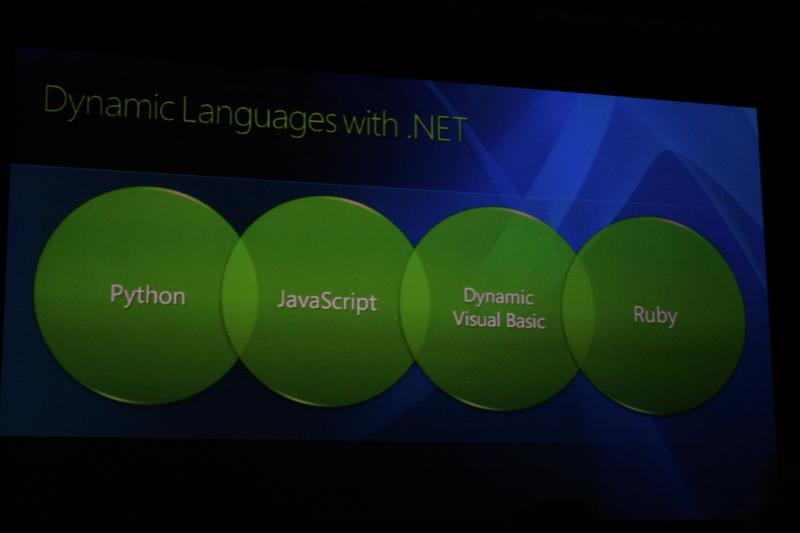
Binaries of the DLR were released today as part of Silverlight 1.1, and the source code was included with IronPython 2.0 (also released today).
The release for the DLR is done under the terms of the Microsoft Permissive License (MsPL) which is by all means an open source license. This means that we can use and distribute the DLR as part of Mono without having to build it from scratch. A brilliant move by Microsoft.
During the keynote they announced support for four dynamic languages built on top of the DLR: Python, JavaScript (ECMAScript 3.0), Visual Basic and Ruby.
The rumor on the halls is that IronPython and Ruby will be released under the MsPL license, while ECMAscript and Visual Basic will continue to be proprietary. From Jim's announcement:
For the short term, our focus is on using a small number of languages to drive the first wave of DLR development where we can work closely and face-to-face with the developers in order to iron out the worst kinks in the DLR design. After this initial phase, we want to reach out to the broader language community. If you're building a language on top of .NET and are interested in supporting dynamic language features then we want your feedback on the DLR. However, I'd discourage you from trying to implement on top of the DLR today. I don't want you to get frustrated trying to work with these really early bits and then not be interested in working with us when we're better prepared to engage with the language community. We plan to kick off a broader engagement with language implementers at the upcoming lang.net conference in three months - at the end of July. This will be the best place to really engage with the DLR and let us know what we got wrong.
Mono and Silverlight
For a long time a common question to the Mono team was when we were planning on implementing WPF.
Most people want to hear a date like "tomorrow", "next month", "in a year". But the answer is more complex than just thinking "we can do this in N months".
We as a team have to evaluate the cost of implementing a technology and contrast it with the impact that such technology would have. With our finite development resources (in the Mono community and the companies contributing to it) we have to pick our battles.
And implementing WPF was never really high up on the priority list for a couple of reasons:
- WPF requires a very big investment before things will start working.
- Users of WPF is limited to those starting new applications and are willing to start those applications using WPF.
- Only a minority of existing users (Windows.Forms) were willing to rewrite their software to move it to WPF. The rest basically will continue developing Windows.Forms and using the technologies they have been using for the time being.
So it is fair to say that we currently do not have plans to look at WPF.
But a Mono-based Silverlight is an entirely different story. Unlike WPF that requires people to rewrite their software to take advantage of it, Silverlight is aimed at the Web and it will become a nice complement, a way of spicing up existing web applications without rewriting what already works.
It makes tons of sense for us to start looking at an implementation of Silverlight on Linux with Mono. There is already a XAML loader, it is the perfect excuse to use Antigrain for high-speed graphics and that only leaves the pesky media issue to be solved.
In fact, am kind of happy that Microsoft did not do the port themselves as implementing this sounds incredibly fun and interesting.
Upsides
The major upside of this show has been how open the Microsoft folks have been open to discuss technicalities of any sorts.
I had the chance of participating on an open source panel at the conference and PHP, Mozilla, SubSonic.NET and Mono were well represented and I did not fell any angry mood from anyone.
There is also a surprising amount of talk about using the MsPL license, again, all good news.
Finally, I also made tons of new friends, have had a great time with everyone I have met here. I also noticed that both Jon Udell and Dave Winer both look happier, they were always smiling,
IE 8?
Someone mentioned (and I forget whom it was) that talk about IE8 was strangely missing from the whole conversation. There were no announcements about new upcoming features in IE, no mention of whether IE8 will support what-wg nor any future plans.
Predictions
So how did my predictions score?
- "They will spend most of the time showing the new features in the recently released Orcas and probably the Silverlight media encoder." At least on the keynote there were little demos of Orcas, most of the demos were demos about Expression, but they did show the Silverlight media encoder. Am going to give myself half a point.
- "There will be a fresh Silverlight update." score 1.
- "Blend and Expression Design will probably ship as a final product, or a new beta will be released." They did. score 1.
- "Dynamic Language Runtime: a set of class libraries with some sort of supporting infrastructure in the CLR to help dynamic language authors speed up their code.". score 1.
- "Javascript: probably Microsoft will announce that they are upgrading the JScript compiler in .NET." Although they did announce that it would be writing a new JavaScript compiler, it is not clear if its a research prototype to test the DLR or the real thing, so am going to go with half a point.
- "Silverlight will bundle a micro-clr." Silverlight bundled a full CLR. So zero points, although I was close.
- "Silverlight for Linux. And if there is no announcement, we should try to get someone drunk enough to get them to do it." There was no announcement of Silverlight for Linux, but I was still kind of joking. But I did get drunk with senior Microsoft employees. One point.
So 5 point out of 7, not bad.
Update: Deepak Jain points out that the new Javascript implementation is not a research prototype, but their new Javascript implementation. The real thing.
Which gives me full point, so 5.5 out of 7, I think I fared better than most analysts and pundits. I should become an analyst at RedMonk in my next life.
Posted on 01 May 2007
Right-sizing the API
Jason Zander's blog entry on the Silverlight announcement contains a very important information nugget:
2. The APIs we are releasing are "right sized". That means we looked for the most powerful subset we could find while keeping the size small.
This I think is what makes Silverlight so interesting to me. Compared to WPF which is a complete framework for desktop applications, they are doing an effort to keep the APIs to a minimum.
Default Widgets: Silverlight comes with no pre-defined widgets, and although at first this seems like a weakness, during one of the presentations today it was clear that one-size-fits-all was not going to give everyone what they wanted.
I believe it was during Mike Harsh presentation, where he created a nice looking custom button out of simple primitives.
Posted on 01 May 2007
Blog Search
Archive
- 2024
Apr Jun - 2020
Mar Aug Sep - 2018
Jan Feb Apr May Dec - 2016
Jan Feb Jul Sep - 2014
Jan Apr May Jul Aug Sep Oct Nov Dec - 2012
Feb Mar Apr Aug Sep Oct Nov - 2010
Jan Feb Mar Apr May Jun Jul Aug Sep Oct Nov Dec - 2008
Jan Feb Mar Apr May Jun Jul Aug Sep Oct Nov Dec - 2006
Jan Feb Mar Apr May Jun Jul Aug Sep Oct Nov Dec - 2004
Jan Feb Mar Apr May Jun Jul Aug Sep Oct Nov Dec - 2002
Jan Feb Mar Apr May Jun Jul Aug Sep Oct Dec
- 2022
Apr - 2019
Mar Apr - 2017
Jan Nov Dec - 2015
Jan Jul Aug Sep Oct Dec - 2013
Feb Mar Apr Jun Aug Oct - 2011
Jan Feb Mar Apr May Jun Jul Aug Sep Oct Nov Dec - 2009
Jan Feb Mar Apr May Jun Jul Aug Sep Oct Nov Dec - 2007
Jan Feb Mar Apr May Jun Jul Aug Sep Oct Nov Dec - 2005
Jan Feb Mar Apr May Jun Jul Aug Sep Oct Nov Dec - 2003
Jan Feb Mar Apr Jun Jul Aug Sep Oct Nov Dec - 2001
Apr May Jun Jul Aug Sep Oct Nov Dec